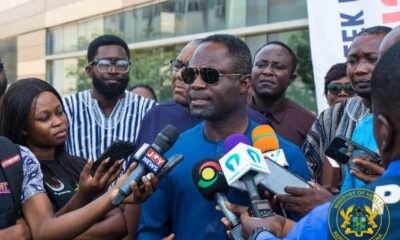Features
Is Aŋlɔ State under siege?

Torgbui-Sri-III
I might not have been born in my hometown of Anyako, but I spent 15 solid years from 1957 in the Aŋlɔ State attending basic and secondary schools.
During this period I learned the Ewe language and literature, our sojourn to our current location from the present Benue State of Nigeria through Ketu (also in Nigeria), Ŋɔtsie and Tsevie.
I know my people would have still gone west, crossing the Volta river, but for the advanced age of the great Torgbui Wenya who, after having led his people through thick and thin, felt he was too advanced in age to continue further. Every Aŋlɔ worth their heritage knows how their new identity came about and Aŋlɔgā (Anloga) became its capital.
As a student at Zion College at Aŋlɔgā I took the trouble to visit the historical sites that I learned about in Middle School. I saw myself living through our history as a people and tribe.
Not only that; I felt a deep sense of belonging. It confirmed my understanding of our communality and responsibility towards one another, fierce honesty and abhorrence of evil.
I knew also that only the Bate and Adzovia clans could ascend the throne as Awoamefia, the Overlord of the Aŋlɔ State. Coming from the Liké Clan disqualifies me to ever become the Awoamefia. But thankfully, I come from the Royal Akornu House of Anyako.
All that I have seen captured in our historical narrative is that Torgbui Wenya anointed and installed his nephew (his sister’s son) as Awoamefia Torgbui Sri. But the narratives do not tell us why Torgbui Wenya chose his nephew over others in spite of the Dogbo (that’s who they were) custom of patrilineal inheritance.
Some analysts say Torgbui Wenya saw greater leadership qualities in his nephew than any other person who could be a candidate. Of course, this is not new in human history.
So, our great leader and founder of the Aŋlɔ State, issued this as an edict that has been with the Aŋlɔ State till date. As Dutɔ (custodian of the land) he became kingmaker. This was his prerogative.
In fact, Amega Wenya’s nephew Fuiga Kponoe, was the Prince and heir apparent of the Tado Ewe when he ran away with the Stool to join his maternal uncle Wenya and the Dogbo Eυe in Ŋɔtsie. This proclaiming him was a master stroke that united the hitherto separated Tado and Dogbo Eυe into one monolith in Ŋɔtsie.
There is no recorded challenge to Torgbui Wenya’s decision and the people of Aŋlɔ have lived with this for centuries. As a result, we have had the following Awoamefia:
1. Torgbui Sri I (1468-1504);
2. Torgbui Adeladza I (1504-1524);
3. Torgbui Zanyedo I (1525-1538);
4. Torgbui Akotsui I (1540-1568);
5. Torgbui Ŋditsi I (1568-1594);
6. Torgbui Adzanu I (1595-1630);
7. Torgbui Agodomatu I (1631-1660);
8. Torgbui Agodeha I (1661-1685) and
9. Torgbui Aholu Nunya I (1686-1725).
They were followed by
10. Torgbui Atsia I (1726-1776);
11. Torgbui Atsiasa I (1784-1810);
12. Torgbui Letsa Gbagba I (1810- 1840);
13. Torgbui Amedor Kpegla I (1849- 1906);
14. Torgbui Sri II (1906-1956) and
15. Torgbui Adeladza II (1957-1997).
The Awadada (Warlord) Torgbui Agbesi Awusu II acted as Awoamefia from 1997 till the current Awoamefia Torgbui Sri III was installed in 2011 as the 16th Awoamefia of Aŋlɔ.
As stated earlier, the succession process that brought in the current Awoamefia was as murky as it was confusing, especially for those of us not within the Bate and Adzovia Clans. Until very recently, when someone was purporting to be Torgbui Wenya III, there had been a relative quiet in Aŋlɔ.
Actually, the succession of the current Awoamefia was due mainly to opportunism and greed within the Adzovia Clan, which disunity has gravely affected effective Traditional governance in Aŋlɔ.
From the listed succession of Awoamefia, one could deduce that nothing has ever been heard of a Torgbui Wenya as Dutɔ of Aŋlɔ aside of the great founder of the Aŋlɔ State and dynasty, Dutɔ Wenya who anointed and installed his nephew as Awoamefia.
It is difficult to understand why someone would pop up and lay claim to a position not recognised as having been part of our recent traditional norms and practice, unless the claimant has an agenda only he and his handlers (if there are any) know. Personally, I suspect political paymasters whose avowed aim is to divide and rule the people.
Assuming, without admitting, that it was wrong for the great Torgbui Wenya to install his nephew as Awoamefia, do we rise up after almost five hundred years to want to right the wrong? If this were allowable, should there not be a process or template for such? Have these been followed or this so-called Torgbui Wenya III is only an attention seeker bent on destroying the Aŋlɔ State?
Aŋlɔ has gone through turbulent times and this is an inauspicious moment to sew any seed of disunity among the people. Already, political chicanery has been deployed to decimate the Aŋlɔ unity by carving out and creating paramountcies to stand on their own. We should not tolerate any malicious attempt to destroy us further by selfseekers or those dancing to the tunes of self-serving characters.
The paramountcies thus created must follow the example and time tested practice of Asanteman where all Asante paramountcies owe allegiance and deference to the Asantehene. Sadly, the current Awoamefia does not seem to want to exert his authority in this regard.
I must point out that our traditional rulers have held this country together more than any politicians have ever attempted to. Indeed, politicians benefit from our disunity as different tribal groups than they will admit to. This is why it is dangerous to want to sew disaffection in any of our traditional areas.
Now, the Ministry of Chieftaincy Affairs has written to the Dutɔ Wenya III to desist from carrying himself as such. Methinks that should have put paid to the activities of this fellow, but he fired back at the Ministry as if it does not know what it is about.
As I write, the Accra High Court is to sit on a case of one injunction or another on the celebration of this year’s Hogbezā. I am careful not to dwell on the legalities as I am not a lawyer. My understanding is that the fellow holding himself as Dutɔ is a lawyer.
I have watched video clips of some young women of Aŋlɔ lambasting the people involved in this Chieftaincy saga. Their contention is that it is a needless exercise for grown men to squabble over who has traditional authority while Aŋlɔ wallows in abject underdevelopment and poverty.
Much as their concerns make a lot of sense, it must be borne thoroughly in mind that a harmonious traditional area gives assurance to investors in development and commercial projects. It is timely, though, to call for sane minds so the area can see development.
Personally, my take is that the weakness of the Awoamezi is the reason why Aŋlɔ has come to this. Court or no Court, methinks the invocation of the time-tested Great Oath of Aŋlɔ could settle this once and for all. If this will cleanse us of miscreants, usurpers and selfseekers, so be it. We have a tradition to keep and customs to uphold. Nothing should break our sanity as a people.
By Dr. Akofa K. Segbefia
Writer’s email address:
akofa45@yahoo.com
Features
Who knows tomorrow?
Recently a friend posted a sad news on his Facebook page, announcing the death of a school mate who had passed away, suddenly. The report had it that he was on his way to the airport to take a flight to Ghana.
I am sure this man had already informed the wife or a friend or a work colleague at work that he was returning home but he was not to return as a human being but as a dead body.
Such is life and so we need to be circumspect in how we go about things in life. The Bible reminds us that we are like grass which at one point in time looks elegant and the next moment becomes withered according to Psalm 90:5 and 6. It is for this reason that we need to guard our hearts with the word of God so that we shall be motivated to do the right thing, at all times.
This will enable us live on this planet, free from all sorts of troubles in our personal lives, even if we ignore the question of Heaven and Hell. Living a disciplined life delivers us from any kind of trouble as the Bible declares in Galatians 5:23 that against such there is no law.
The uncertainty surrounding our lives on earth is the more reason why people should commit their lives into the hands of the one who created it, in the first place unless you believe that the world created itself and that it appeared from nowhere.
Otherwise, the logical thing to do is to recognize the authority of the creator and surrender to his Lordship. Heaven is real and Hell is real, so for us who know the truth and have received Jesus as our Lord and Saviour, the onus lies on us to encourage our relations who have not believed and received Jesus into their lives, to do so.
We are a couple of days from another Easter Resurrection celebration and an opportunity to reflect on our lives in relation to the significance of Easter. In the Bible, the only occasion Jesus, Saviour of the world commands us to celebrate is his death and resurrection.
He never commanded his followers to celebrate his birth but like everything else, we chose to ignore Jesus’s instructions and decided to do what pleases us, just like our forefather and mother in the Garden of Eden.
Let us deliberately choose to do things differently as Christians this Easter, so we can really benefit from all the blessings that the celebration of the death and birth of Jesus, has on offer. Doing the same thing over and over and expecting a different result is definitely insanity.
I choose to be different this Easter and I am believing God for a newness of life so God’s glory would be revealed in me to draw the unsaved to him. It is only when people especially the unsaved, see the character of Christ in us, that they can be convinced about the authenticity of Jesus, as Saviour of the world, who can bring transformation in their lives too.
This is what would motivate them to surrender their lives to Jesus Christ. Let us make this Easter a memorable one that will be cherished for a long time. It is also a period for reconciliation and it would be great if in the spirit of Easter, we would try to reach out to those who have wronged us or have a grudge against us.
This would demonstrate that we have indeed accepted Jesus and that our religious posture is not a sham. May the good Lord grant us the grace to love our neighbours as ourselves, demonstrating the love of God in the process.
Those who have lost their loved ones and Easter brings sad memories, may the good Lord comfort and strengthen you. God bless.
.NB: ‘CHANGE KOTOKA INTERNATIONAL AIRPORT TO KOFI BAAKO INTERNATIONAL AIRPORT’
Features
Cosmetic deformities
COSMETIC deformities refer to physical imperfections or abnormalities that affect an individual’s appearance, often causing emotional distress and impacting their quality of life.
These deformities can be congenital, acquired, or result from various medical conditions or treatments. This article provides an in-depth exploration of cosmetic deformities, their types, causes, effects, and treatment options.
Types of cosmetic deformities
Cosmetic deformities can affect various parts of the body, including the face, skin, hair, nails, and teeth. Some common types of cosmetic deformities include:
1. Facial deformities: Congenital or acquired abnormalities affecting the shape, structure, or appearance of the face, such as cleft lip and palate, facial paralysis, or facial asymmetry.
2. Skin deformities: Conditions affecting the skin’s texture, tone, or appearance, such as acne, scars, birthmarks, or skin discoloration.
3. Hair deformities: Abnormalities affecting the hair’s growth, texture, or appearance, such as alopecia, hirsutism, or hair loss due to medical conditions or treatments.
4. Nail deformities: Conditions affecting the shape, size, or appearance of the nails, such as nail fungus, nail psoriasis, or nail trauma.
5. Dental deformities: Abnormalities affecting the shape, size, or appearance of the teeth, such as tooth decay, tooth loss, or malocclusion.
Causes of cosmetic deformities
Cosmetic deformities can result from various factors, including:
1. Genetics: Congenital conditions or inherited traits can cause cosmetic deformities.
2. Trauma: Injuries or accidents can result in cosmetic deformities, such as scars or facial trauma.
3. Medical conditions: Certain medical conditions, such as acne, psoriasis, or eczema, can cause cosmetic deformities.
4. Treatments and procedures: Medical treatments, such as chemotherapy, radiation therapy, or surgery, can result in cosmetic deformities.
5. Aging and environmental factors: Aging, sun exposure, and environmental factors can contribute to cosmetic deformities, such as wrinkles, fine lines, or age spots.
Effects of cosmetic deformities
Cosmetic deformities can have significant emotional and psychological effects on individuals, including:
1. Low self-esteem: Cosmetic deformities can lead to feelings of insecurity, self-consciousness, and low self-esteem.
2. Social anxiety: Individuals with cosmetic deformities may experience social anxiety, avoiding social interactions or feeling embarrassed in public.
3. Emotional distress: Cosmetic deformities can cause emotional distress, including depression, anxiety, or stress.
4. Impact on quality of life: Cosmetic deformities can affect an individual’s quality of life, impacting their relationships, career, or overall well-being.
Treatment options for cosmetic deformities
Various treatment options are available to address cosmetic deformities, including:
1. Surgical procedures: Surgical procedures, such as reconstructive surgery, cosmetic surgery, or dermatological surgery, can correct or improve cosmetic deformities.
2. Non-surgical treatments: Non-surgical treatments, such as laser therapy, chemical peels, or microdermabrasion, can address cosmetic concerns, such as skin texture, tone, or appearance.
3. Medical treatments: Medical treatments, such as topical creams, oral medications, or injectable treatments, can address cosmetic concerns, such as acne, hair loss, or nail deformities.
4. Prosthetic and orthotic devices: Prosthetic and orthotic devices, such as wigs, hairpieces, or dental prosthetics, can help individuals with cosmetic deformities.
5. Counselling and therapy: Counselling and therapy, such as cognitive-behavioral therapy or psychotherapy, can help individuals cope with the emotional and psychological effects of cosmetic deformities.
Conclusion
Cosmetic deformities can have significant emotional and psychological effects on individuals, impacting their quality of life and overall well-being.
Understanding the types, causes, and effects of cosmetic deformities is crucial in addressing these concerns.
Various treatment options are available, ranging from surgical procedures to non-surgical treatments, medical treatments, prosthetic and orthotic devices, and counselling and therapy.
By seeking professional help and support, individuals with cosmetic deformities can improve their appearance, boost their self-esteem, and enhance their overall quality of life.
Reference
1. “Cosmetic Deformities” by the American Society of Plastic Surgeons







